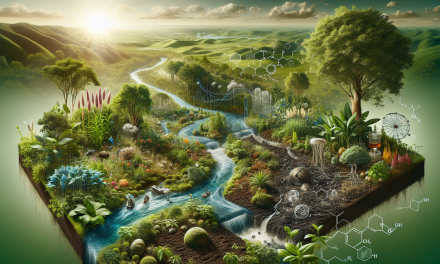Table of Contents
- Introduction
- What is Environmental Chemistry?
- Why Is Environmental Chemistry Important?
- Key Concepts in Environmental Chemistry
- Applications of Environmental Chemistry
- Impact on Health and the Environment
- The Future of Environmental Chemistry
- FAQs
- Conclusion
Introduction
Understanding the delicate balance between the environment and its chemical components is crucial. In this exploration, we delve into the intricacies of environmental chemistry. This broad and engaging field encompasses various aspects—ranging from air and water quality to climate change and sustainable practices. Environmental chemistry plays a significant role in addressing pressing global issues.
What is Environmental Chemistry?
To define environmental chemistry, we must consider it as the branch of chemistry that focuses on the chemical and biophysical processes occurring in the environment. It examines how various substances interact within natural systems. Moreover, it investigates the impact of human activities on these chemical cycles.
The Components of Environmental Chemistry
Environmental chemistry deals with several core components, including:
- Soil Chemistry: Understanding the chemical makeup of soils helps in assessing nutrient availability and pollutant interactions.
- Water Chemistry: Analyzing water quality is vital for public health and ecosystem sustainability.
- Atmospheric Chemistry: This involves studying gases, particles, and chemical reactions occurring in the atmosphere.
Why Is Environmental Chemistry Important?
Numerous reasons underline the significance of environmental chemistry. Firstly, it aids in understanding pollution and its sources, leading to effective mitigation strategies. Secondly, it allows scientists and policymakers to address environmental challenges, such as climate change and resource management.
Informed Decision-Making
Through environmental chemistry, individuals and governments can make informed choices that promote sustainable practices. For instance, the analysis of pollutants enables the formulation of regulations that protect natural habitats. Thus, a thorough understanding of environmental chemistry ultimately contributes to public health and ecological balance.
Key Concepts in Environmental Chemistry
Several key concepts form the backbone of environmental chemistry. By grasping these ideas, one gains valuable insights into chemical interactions in various environmental contexts.
Biogeochemical Cycles
Biogeochemical cycles refer to the continuous flow of elements and compounds through different environmental compartments, including the atmosphere, hydrosphere, and lithosphere. Key cycles include:
- Carbon Cycle: Involves the movement of carbon in its various forms through the ecosystem.
- Nitrogen Cycle: Focuses on the transformation of nitrogen and its role in living organisms.
- Phosphorus Cycle: Essential for understanding nutrient availability in ecosystems.
Environmental Analysis
Environmental chemists employ various analytical techniques to assess the quality of air, water, and soil. Techniques such as chromatography, spectrometry, and mass spectrometry are commonly used to detect contaminants and evaluate their concentrations.
Applications of Environmental Chemistry
Environmental chemistry finds application in various domains. For example, its principles guide pollution control measures, waste treatment processes, and remediation efforts. Moreover, environmental chemists contribute to developing clean technologies and sustainable practices to minimize ecological footprints.
Pollution Prevention and Control
One of the primary applications of environmental chemistry is pollution prevention. By identifying sources of pollution, chemists can provide insights into reducing emissions and improving waste management practices.
Furthermore, innovative technologies derived from environmental chemistry help monitor and control pollutants effectively. This leads to cleaner air and water, promoting healthier communities.
Innovations in Environmental Chemistry
Recent advancements in environmental chemistry reveal innovative strategies for addressing environmental issues. Green chemistry, for instance, emphasizes minimizing hazardous substances and promoting sustainable materials and processes. This principle aligns with the growing interest in ecological conservation and resource efficiency.
Impact on Health and the Environment
Undoubtedly, the interplay between chemistry and health remains a critical aspect of environmental studies. Toxic substances, often resulting from industrial processes or agricultural runoff, pose significant risks to both human and ecological health.
Toxicology and Exposure Assessments
Environmental chemists study toxic substances to understand their effects on living organisms. Toxicology examines how chemicals interact with biological systems, leading to potential health risks. Importantly, exposure assessments determine how individuals and ecosystems come into contact with these hazardous materials.
The Future of Environmental Chemistry
As global challenges like climate change intensify, the importance of environmental chemistry will only grow. Research will continue to unveil the complexities of chemical interactions in the environment, paving the way for innovative solutions.
Emerging Trends
Future developments in environmental chemistry may include:
- Nanotechnology: Utilizing nanoparticles for environmental remediation and monitoring.
- Bioremediation: Harnessing microorganisms to clean up contaminated sites.
- Sustainable Materials Science: Focusing on developing materials that minimize environmental impact.
FAQs
What are the main fields within environmental chemistry?
Environmental chemistry encompasses a variety of fields, including soil chemistry, water chemistry, atmospheric chemistry, and analytical chemistry. Each of these fields focuses on different aspects of chemical interactions in the environment.
How does environmental chemistry contribute to tackling climate change?
Environmental chemistry provides crucial insights into the processes contributing to climate change. By studying greenhouse gases and their sources, chemists can identify strategies to reduce emissions and develop more sustainable practices that mitigate climate change impacts.
Conclusion
In summary, the exploration of environmental chemistry sheds light on the intricate relationships between chemicals and their effects on the world around us. From understanding biogeochemical cycles to developing innovative solutions for pollution control, the knowledge derived from this field is invaluable. As we look towards the future, ongoing research will continue to inform decision-making and guide us toward a more sustainable existence.
For those interested in delving deeper into environmental chemistry, resources like Explore the Intricacies of Environmental Chemistry, Unlocking the Secrets of Environmental Chemistry, Mastering Environmental Soil and Water Chemistry: A Comprehensive Guide, and Mastering Chemical Engineering: Essential Concepts and Practical Solutions provide valuable information and insights that can enhance understanding and foster a new generation of environmental stewards.





